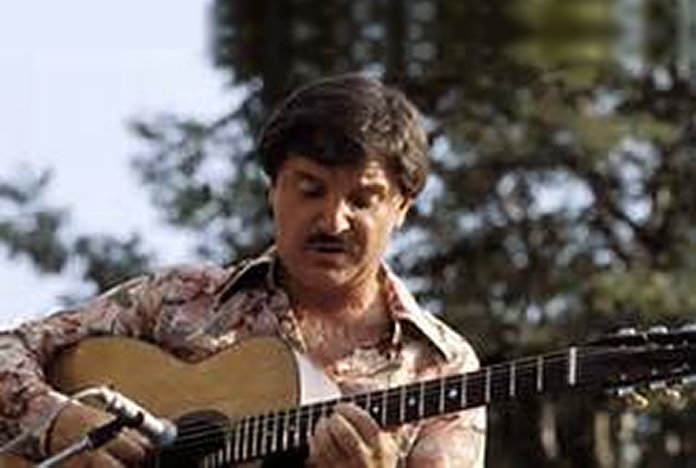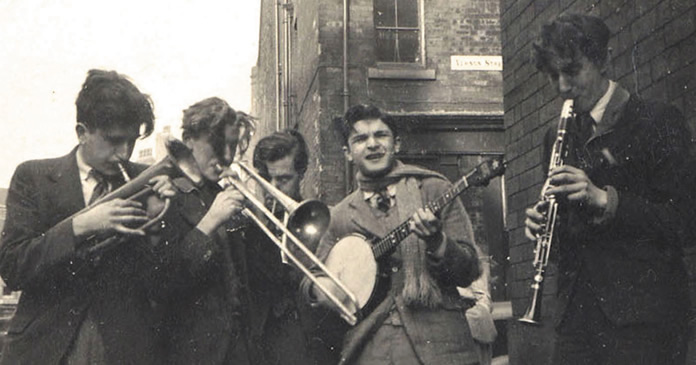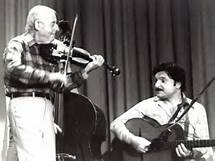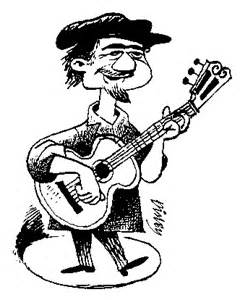Diz Disley remembered too
Back
We take an affectionate look at the life and times of William Charles Disley, otherwise known as ‘Diz”
By Jamie Evans
As I write it is nearly seven years since the guitarist and banjoist, William Charles Disley, passed on and one of the great “characters” of the British jazz scene is well worth a few affectionate recollections.
To start with, I was never a close friend of Diz but he was a close friend of one of my close friends - that is Alan Cooper to whom of course this website is dedicated.
Coops was a through-and-through Yorkshireman while Diz was more of a hybrid although their life-long friendship was forged at Leeds College of Art where they were both students in the late ‘40s and early ’50s.
This isn’t an attempt at another obituary, so I am recording random experiences of myself and other friends and musicians not necessarily in any chronological order.
Diz and Coops both played in the college band, the Vernon Street Ramblers.This era was very much the heyday of the traditional jazz revival and many of the streets, squares, pubs and clubs must have rung to the sound of their banjo and clarinet.

Vernon Street Ramblers 1952. Diz and Coops far right.
That band formed the basis of the Yorkshire Jazz Band which went on to become a successful part of the British scene.
Remarkably, that band contained another musician who would go on to become a substantial figure in British music. Trumpeter Dick Hawdon subsequently played in the traditional context with Terry Lightfoot and changed horses by becoming a leading modernist with Johnny Dankworth and others.
Coops’ later life and career has been extensively covered in articles on the site, so we’ll stick to the remarkable talents and career of Diz himself.
After his Leeds beginnings Diz put his wide-ranging talents to many other areas.
He played in skiffle groups, folk bands, leading trad outfits like Kenny Ball, also fitting in stints as a radio presenter. Diz was an extremely talented cartoonist and sold his work to leading publications like the Spectator, Radio Times, and the Melody Maker.
Like many jazz guitarists, his hero was Django Reinhardt, the great Belgian gypsy virtuoso, who had invented his own jazz style incorporating elements of flamenco.
 Diz and Grappelli in action
Diz and Grappelli in action
Along with French violinist Stephane Grappelli, Django made their group the Hot Club world-famous and much loved by jazz enthusiasts.
In the early ‘70s, Diz encountered Grappelli and between them they recreated the sound of the Hot Club. For 10 years they toured the world to the acclamation of thousands of enthusiastic concert-goers.
If the above thumbnail biography makes Diz’s life sound like a classic success story, wait a moment. His character incorporated what George Melly called "built-in anti-success mechanism”.
All his career episodes were marred by missed deadlines, capacity to cause offence and even a spell in jail for income tax evasion. Even his 10-year stint with Grappelli was marred by arguments and his dislike of the violinist’s complaining nature.
To bring back his old friend Coops into the story, both had individual attitudes to money. Coops, in the great Yorkshire tradition, was ever reluctant to relax his purse strings although he did exaggerate this for laughs at times.
Diz as a sort of honorary Yorkshireman, was totally hopeless with money. He earned it, spent it , borrowed, often never repaid loans and at times was reviled for taking advantage of young admirers who were always happy to loan the great man cash but never saw it back.
In my years with the Alan Cooper Trio, Diz would sometimes stay in Coops’ rambling mansion (among the rota of crash pads he inhabited in his later years) which faced Wandsworth Common in south-west London.
He would often turn up to gigs and augment the trio with his guitar, great by me. Who wouldn’t want to play with a fabulous guitarist?
Coops and Diz had one trait in common - their pathological reluctance to buy a round of drinks. They believed, with some justification, that as artists and especially at free admission pub sessions, Joe Public should stand the drinks.
Coops at least would relax his vow with band members and buy Ian (the drummer) and myself a pint occasionally but Diz never did. I guess as he was only guesting as an unpaid player, he expected the earners like myself to pay up. Not unreasonable.
Anyhow the drinks I bought him were always greeted with; “Most acceptable, dear boy.” I waited in vain to hear him utter the words “What’s yours, Jamie?”. It was to no avail.
Both being mainly chordal instruments in a jazz context, guitarists and piano players can sometimes beg to differ on interpretation. Diz and I only ever had one literally minor disagreement when in one tune I played a C6th chord which he told me should have been an A minor. I bowed to rank next time and he was happy.
Shortly after his death I was contacted by my friend guitarist Martin Taylor who took over the Django role from Diz when he parted company with Grappelli.
Martin told me that he actually didn't know Diz very well. When he first worked with Grappelli he took Diz's place while he took some time off. He came back about six months later and Martin did one UK tour and one US tour with him.
Martin thought that Diz was a very talented man,a brilliant cartoonist, and undoubtedly one of the best Hot Club rhythm guitarists he had ever heard.
Martin went on: “From what I can gather from various musician stories, I was fortunate not to have had any direct financial dealings with him, but I was very fortunate to hear him playing the guitar at his very best on several occasions.
“Once in Phoenix, Arizona, he played the best solo I've ever heard on Lady Be Good. The following night in Denver he played the worst I'd ever heard.
“Later that night he got very drunk and lost his trousers in a tree when they were mysteriously blown away by the wind from his hotel balcony. These are things you couldn't make up!”
On April 7, 2010, I attended Diz’s send-off at Kensal Green Crematorium in north London.
Like most of the jazz funerals I have been to, it was a happy occasion, celebrating a popular artist’s life with music and anecdotes. Unfortunately due to illness and Diz’s impecunious state, it was financed mainly by donations from friends and admirers.
I include three of the best speeches out of the many tributes given on that day.
From musician John Pilgrim: “During Diz’s financially successful years when he persuaded Stefane Grappelli to return to the Django format, he asked someone to lend him a tenner. Noting the look of surprise on the potential donor’s face he explained: ‘I’m between millions at the moment.’ ”
Musician Gerry Higgins told the congregation “Diz was in Spain staying at Dick Charlesworth’s bar in Mojahar, near Almeria. He had just bought an Austin Princess which he had driven all the way.
“Dick was running short of beer for the bar and Diz offered to drive him to a wholesaler and bring it back in the Austin Princess. Mojahar is built on a steep hill and they returned to the bar and went to open it up.
“Diz forgot to press “PARK” and the car rolled backwards down the hill, careered off the road , did two somersaults and created the biggest beer fountain in Almeria.”
press “PARK” and the car rolled backwards down the hill, careered off the road , did two somersaults and created the biggest beer fountain in Almeria.”
Former 100 Club proprietor Roger Horton contributed an anecdote which accurately reflected Diz’s attitude to money. “Diz was in the habit of dropping in at the 100 club for a beer and a chat and often borrowed a tenner from me which he usually paid back. However when the debt reached £50 he stopped coming to the club which upset me as he always enjoyed Diz’s company,” said Roger.
“I devised a cunning ruse to sort out the problem. Behind the kitchen in the club was an ugly wall and in hot weather it was visible to patrons when the door was open. I commissioned Diz to do a mural to hide the wall and allowed for the debt to be reflected in the fee.
“Diz borrowed some cash on account , built a wooden screen to hide the wall and set to work.
“At the end of the first day I went to see what had been done and observed a blue sky, two white clouds and a seagull. Otherwise it was blank.
“Several weeks went by and the next time Diz dropped in at the club I asked him about the picture. ‘No problem,’ said Diz, ‘I’ll finish it tomorrow.’
“Of course, he didn’t and the weeks, the months, and the decades went by and behind the kitchen at the 100 Club to this day can be seen a wooden board emblazoned with a blue sky, two white clouds and a seagull.”
All this writer can say is, miss you Diz.and on the whole you were “most acceptable, dear boy”.

